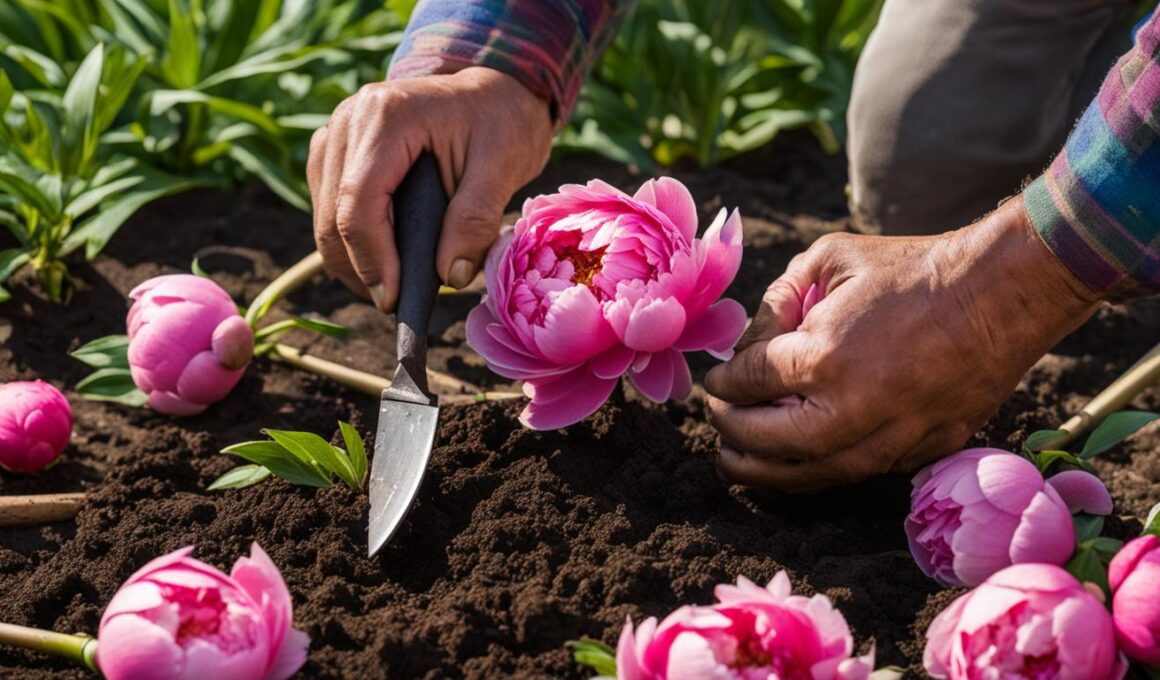Peonies are beautiful flowering plants that can bring vibrant colors and exquisite blooms to your garden. If you want to expand your collection or share the beauty of these plants with others, learning how to propagate peonies is essential. With the right techniques, you can easily create new plants from existing ones, allowing you to enjoy the splendor of peonies in different areas of your garden.
In this article, we will explore the various methods of peony propagation, including dividing mature plants, taking root cuttings, and growing them from seed. We will also provide tips on care and maintenance to ensure the successful growth of your propagated peonies.
Propagating peonies allows you to create new plants and expand your garden.
Methods for Propagating Peonies
There are three primary methods for propagating peonies: division, root cuttings, and seed propagation.
Division: Division is the most common and reliable method for propagating peonies. To divide peonies, start by carefully digging up a mature plant in late summer or early fall. Gently separate the plant into smaller sections, ensuring that each section has multiple buds and roots. Replant the divided sections in a prepared area of your garden, making sure to provide adequate spacing.
Root Cuttings: Taking root cuttings is another way to propagate peonies. Select fleshy sections of the roots that are about 4 to 6 inches long and cut them into smaller pieces, each with a bud. Plant these root cuttings in a nursery bed filled with well-draining soil, making sure to keep them moist until they develop new shoots and roots.
Seed Propagation: Growing peonies from seed is a longer and more unpredictable process, but it can be a rewarding way to create new varieties. Collect ripened seeds from peony plants and soak them in water for 24 hours. Plant the seeds in a dedicated nursery bed, covering them with a thin layer of soil. It may take several years for the seedlings to bloom, but the wait can be worth it for unique and diverse peony flowers.
Each method of propagating peonies has its own requirements and benefits. Division is the most straightforward and immediate method, while root cuttings and seed propagation offer the chance to create new plants with different characteristics. Choose the method that suits your preferences and gardening goals, and enjoy the beauty of these stunning flowers.
Care and Maintenance of Propagated Peonies
Once you have successfully propagated your peonies, it’s important to provide them with proper care and maintenance to ensure their healthy growth and vibrant blooms. Follow these essential tips to care for your propagated peonies:
- Choose the right planting location: Plant your new divisions or root cuttings in a spot that receives full sun for at least 6 hours a day. Ensure the soil is well-draining and enriched with organic matter to promote healthy root development.
- Plant at the proper depth: When planting your peonies, make sure not to bury them too deep. The eyes (buds) of the peony roots should be no more than one inch below the soil surface. Planting them too deep can hinder their growth and flowering.
- Water regularly: Peonies require regular watering, especially during dry spells or hot summer months. Keep the soil consistently moist but not waterlogged. Deep watering once a week should be sufficient to meet their needs.
- Provide support if needed: Depending on the variety, some peonies may require additional support to keep their stems upright. Use stakes or cages to prevent them from bending or breaking under the weight of their large, lush blooms.
- Ensure good air circulation: Proper air circulation is essential for preventing fungal diseases in peonies. Space your plants adequately, allowing enough room between them to promote airflow and reduce the risk of powdery mildew or other fungal infections.
- Prune in autumn: Herbaceous peonies can benefit from a light pruning in autumn after the foliage starts to die back. Cut back the stems to ground level and remove any faded foliage or seedpods. This helps prevent the spread of diseases and promotes better growth in the following season.
- Watch out for pests and diseases: Keep an eye on your propagated peonies for signs of pests like aphids or diseases like peony wilt. If you notice any issues, take appropriate measures to prevent or treat them promptly. Neem oil or insecticidal soaps can be effective for controlling common pests, while removing and destroying infected plant parts can help manage diseases.
With proper care and attention, your propagated peonies will flourish and reward you with their mesmerizing beauty and bountiful blooms.
Conclusion
Propagating peonies is a rewarding process that allows you to expand your collection and share the beauty of these plants with others. Whether you choose to divide mature plants, take root cuttings, or grow peonies from seed, each method offers its own unique benefits. By following the proper techniques and providing the right conditions and care, you can successfully propagate peonies and enjoy their stunning blooms year after year.
When dividing peonies, ensure that each section has multiple buds and roots to guarantee successful growth. Taking root cuttings can be a great option for producing new plants from existing ones, and growing peonies from seed allows you to explore new varieties. Remember to time your propagation efforts for late summer or early fall, as this is the optimal period for success.
To ensure the long-term health and vitality of your propagated peonies, it is important to provide the right conditions. Plant them in well-draining soil enriched with organic matter, and be mindful not to bury the eyes of the peonies too deeply. Regular watering, full sun exposure, and good air circulation are key factors in promoting healthy growth. Additionally, proper care practices such as pruning, removing faded foliage, and monitoring for pests and diseases will help maintain the beauty and vigor of your peony garden.
With patience, dedication, and the application of the appropriate propagation methods, your peony garden will flourish. Enjoy the stunning blooms and share the joy of peonies with others as you expand your collection and create a vibrant and thriving peony garden that will bring delight for years to come.
Are the Propagation Methods for Peonies and Azaleas Similar?
When it comes to propagating azaleas at home, the methods are quite different from those used for peonies. Azaleas can be propagated via stem cuttings, layering, or seeds, while peonies are typically propagated through division of the root clump. Each method requires different techniques and timing.










